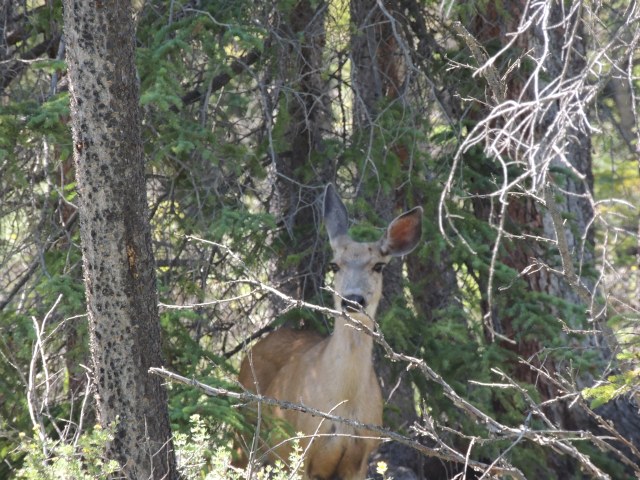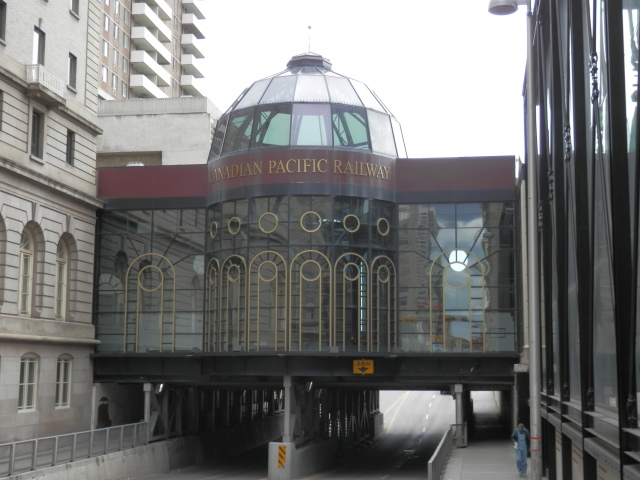Wondering where all the wildlife action was in my posts about the Rockies? Well bear with me (see what I did there?)
As I said here, nature is everywhere in Canada, coming right down to the doorstep in Toronto. Canadians are quite blasé about their wildlife – “Yeah, I’ve seen a bear,” said my friend Rosie casually.
A bear, for heaven’s sake!
I, however, am a little more excitable and when we hit Alberta, I was on all-eyes-alert for anything. ANYTHING.
And I was rewarded pretty early on, with this stunning close encounter with this mule deer in Banff. Leaving Colin to get the photos, I merely stood and watched this magnificent creature – who had no idea she was the focus of the animal paparazzi – eating grass and then calmly walking away.
Now I know it was only a deer, but I spent every trip to the Highlands of Scotland trying to find one and never seeing anything so this was quite something. Plus there was the stillness of the animal juxtaposed with the busy tourist centre we’d left a few minutes previously. We meant nothing to this animal.
Not too much later, driving through to Lake Louise, Colin and I were given an even better treat with the sighting of a beautiful stag walking through the forest. The road was busy and we couldn’t stop for photos but the image is burned onto my memory.
Of course, me being me, I got excited at anything: the many hawks riding the thermals or peering down from telegraph poles; the mountain goat by Canmore: the gorgeous little chipmunks and the gophers we saw on the prairies – the one pictured was obviously used to being photographed and posed like a red-carpet star. Plus there were the dinosaurs at Drumheller.
(The bears remained elusive. The closest we got was several hundred metres where we were told a black bear had gone into bushes. We waited but the bear never reappeared. I did see a cowboy, however, complete with leather chaps standing at the entrance of his farmland.)
But the best came not long after the mountain goat, after my cousin Vicki, in a perfect tribute to The Terminator, announced there was a storm coming in. We decided to get home before it hit and were heading out of the park when something frolicking in a clearing grabbed us all. Vicki slammed on the brakes.
“Could be cougars,” she said, looking back at the three animals.
I swear, if I’d had a tail it would have stared wagging.
And then she said: “Nope. There’s too many. Cougars are loners. They’ve got to be wolves.”
God bless her, storm gathering pace, she reversed the car back to where the animals were. That’s where this picture was taken. Stepping out of the car and viewing the creatures more closely, it was obvious that these were large animals and everything about them looked like wolves.
So why the bad photo? As I lifted my camera up, Mother Nature showed that she’s more than wildlife. Within seconds, the rain came hurtling down and the wind picked up, literally knocking the camera as I tried to hold it steady. I had no choice but to run back to the car, already soaking after less than 30 seconds.
It was the beginning of August yet we were in the middle of a hailstorm so loud and violent you would have thought someone was bombarding us with golf balls. I expected the windshield to shatter at any moment. Vicki had told me about cars being damaged by hailstones. Now I understood (and also why the car insurance is so expensive in Alberta compared to the UK).
The car was silent (we wouldn’t have been able to hear each other anyway) and Vicki received a round of applause when we emerged at the other side of the storm. That was serious driving.
This was the end of my Rockies adventures and they moved me more than I had expected. My author friend Douglas Jackson – who writes a brilliant blog – once talked about going up on the Borders of Scotland and England and seeing views that the Romans had seen almost 2,000 years ago. Watching these animals in their natural habitat, I understood perfectly what he meant: the sense of timelessness and unity as I watched a scene that the First Nations would have seen; a Canada from long, long ago. This was compounded by the storm – we were powerless, nature was in control. After all, only a few weeks earlier, Calgary and the surrounding areas had been devastated by heavy rains.
I’ve always hated the idea of borders and nations and visas and immigration quotas and my experiences in the Rockies made me see even more how we don’t own the earth, it does not belong to us, we only share it with all the rest of its inhabitants, we’re all just lodgers on this land. Perhaps we should send the world’s politicians to Alberta so they can learn this lesson too.
I can’t thank my family in Calgary enough for an amazing week filled with laughter and love and many, many memories (Vicki, I still feel guilty for the black eye I gave you when you were a little girl). I love you all and I hope it won’t be another 20-something years before we meet up again.
Related articles
- Yee-haw! We’re off to see the cowboys (canadianwry.wordpress.com)
- Alberta floods the costliest natural disaster in Canadian history: IBC (o.canada.com)





